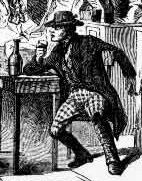The Temperance ExhibitThe Lost Museum Archive

During the four decades prior to the Civil War, American society confronted increasing urbanization, immigration, and changes in the nature and structure of work brought on by industrialization. Many men and women, inspired in part by evangelical Christianity, undertook a host of "moral reform" movements intended to encourage self-control and cure such social ills as poverty, crime, and insanity. Temperance was one such reform movement. The American Society for the Promotion of Temperance, founded in Boston in 1826, urged members of the "respectable" classes to reform themselves and relied on "moral suasion" as a method. By the 1840s, working-class men joined the temperance cause by forming Washingtonian Societies, and the temperance movement began to advocate complete prohibition of alcohol rather than moderation in its use. In 1851 the state of Maine passed a law outlawing the sale of all forms of alcohol; eleven other states and territories followed.
Not merely a political debate, temperance permeated American culture through tracts, dramas, songs, and illustrations that presented stories of liquor-induced fall and redemption, not to mention the temperance conventions and parades that took place in many cities and towns. Barnum, a staunch temperance advocate, promoted the cause of sobriety at the American Museum in a variety of ways. Beginning in 1849, he drew large audiences to the Lecture Room with The Drunkard, or The Fallen Saved, a pro-temperance moral melodrama. Barnum also served free ice water on every floor of the Museum, employed plainclothes detectives to eject patrons "whose actions indicated loose habits," and forced male Lecture Room audience members who spent intermission at a nearby saloon (a long-standing theatrical tradition) to pay a second admission fee when they returned for the second act.